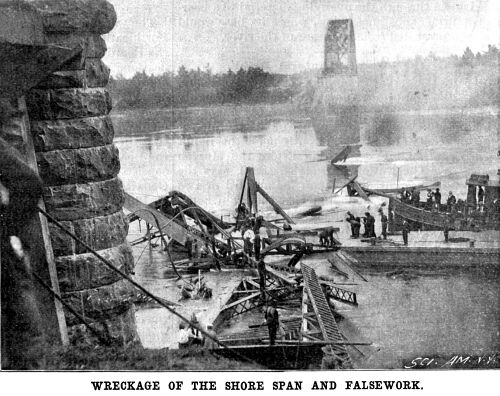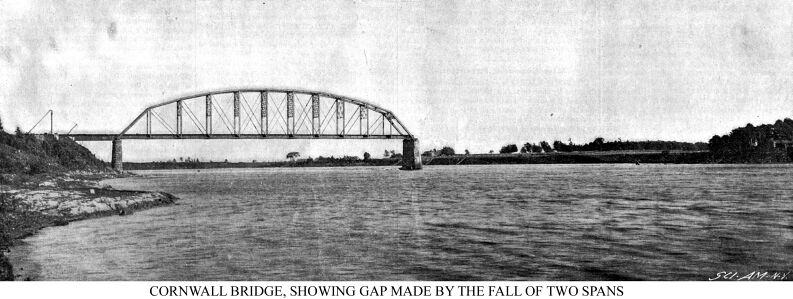THE FALL OF A BRIDGE AT CORNWALL, ONTARIO.
Scientific American—October 1, 1898
 The great advance which has been
made of late years in the theory and construction of long span
bridges is proved by the small number of accidents that has occurred
to structures of the kind that have been built by first class
firms and under the supervision of qualified engineers. As regards
the superstructure, that is, the bridge proper, it may be said
that the possibility of serious failure or complete collapse due
to inherent weakness has been practically eliminated; and it is
only in the substructure, the foundations and piers, that any
doubts as to stability may ever be said to exist. Even as regards
the subaqueous foundations, it is only in rare cases that the
engineer is unable to state with absolute certainty that they
are permanently stable; for modern methods of diving and boring
make it possible to learn with great certainty the composition
of the river bottoms and determine how far it is necessary to
carry down the foundations before they rest upon a durable stratum
of ample bearing capacity to carry the superimposed structure. The great advance which has been
made of late years in the theory and construction of long span
bridges is proved by the small number of accidents that has occurred
to structures of the kind that have been built by first class
firms and under the supervision of qualified engineers. As regards
the superstructure, that is, the bridge proper, it may be said
that the possibility of serious failure or complete collapse due
to inherent weakness has been practically eliminated; and it is
only in the substructure, the foundations and piers, that any
doubts as to stability may ever be said to exist. Even as regards
the subaqueous foundations, it is only in rare cases that the
engineer is unable to state with absolute certainty that they
are permanently stable; for modern methods of diving and boring
make it possible to learn with great certainty the composition
of the river bottoms and determine how far it is necessary to
carry down the foundations before they rest upon a durable stratum
of ample bearing capacity to carry the superimposed structure.
The terrible disaster at Cornwall, Ontario, in which a river
pier and two adjacent spans fell into the river, is a case (now
happily very rare) of the collapse of a presumably first class
structure which was being erected by well known contractors under
the supervision of engineers of standing and reputation. For the
reason that the swiftness of the current has prevented any thorough
examination of the river bottom, it is impossible to determine,
except by conjecture, the cause of the disaster; but such facts
as can be gleaned point to the probability of the swift current
having undermined the first pier from the south shore, causing
it to fall over, dragging the shore span and the intermediate
span with it.
 The bridge is located near the
Long Sault Rapids of the St. Lawrence River. It consists of a
draw span over the canal, a cantilever across the north channel,
and three spans across the south channel of the river, each of
latter being 370 feet in length. At the time of the disaster the
piers had all been built, and the three 370-foot trusses had been
practically completed, the two river spans being swung and the
falsework still remaining beneath the shore span. The bridge is located near the
Long Sault Rapids of the St. Lawrence River. It consists of a
draw span over the canal, a cantilever across the north channel,
and three spans across the south channel of the river, each of
latter being 370 feet in length. At the time of the disaster the
piers had all been built, and the three 370-foot trusses had been
practically completed, the two river spans being swung and the
falsework still remaining beneath the shore span.
At the time of the accident a large force of men was at work
on the shore span, and the crash appears to have come without
the least preliminary warning. Fifteen men were killed outright,
and sixteen were seriously injured. The drawings and specifications
were made and drawn up under the direction of F. D. Anthony, chief
engineer of the New York and Ottawa Railway Company, for whom
the bridge is being built, and they were approved by the engineers
of the Canadian government and by Mr. Stewart, the consulting
engineer to the railway company. The contractors for the superstructure
are the Phoenix Bridge Company, and the piers were built by Sooysmith
& Company, of New York.
The testimony of eyewitnesses is pretty well agreed that it
was the pier that collapsed first, and it is probable that the
source of the mischief will be found, as we have said, at the
base of the pier where it rested upon the bed of the river. The
river at this point is deep and swift, the depth being from 35
to 40 feet, and the speed of the current between 5 and 8 miles
per hour. It was decided to sink wooden cribs, fill them with
concrete, and upon this foundation erect piers of solid masonry.
As the current was too swift for examination of the bottom, by
divers, soundings were taken and the approximate contour obtained
in this way. The timber crib was 18 feet wide by 62 feet long
and 38 feet in height. When it was sunk to the bottom, divers
went down and brought up samples of the bottom, which is reported
to consist of clay hardpan overlaid with pebbles and bowlders.
It was considered that the bottom was satisfactory, and the filling
of the crib commenced forthwith. Bags of concrete were laid by
the divers around the sides of the crib to the amount of 50 cubic
yards, and then the concrete was deposited by means of self-discharging
buckets, having a capacity of 1 cubic yard. It was deposited in
18-inch layers, and is stated to have set satisfactorily as the
filling proceeded.
The cribs, which were built in the customary way of 12 x 12
timber walls, securely drift-bolted, and tied together by 12-inch
cross timbers, were built up to a few feet above water. When the
concrete had been carried up to within 4 feet of low water level,
the crib was pumped dry, and the masonry of the pier was started.
It should be mentioned that, during last winter, when work was
shut down with only two courses of masonry in place, the crib
was subjected to severe test by the pressure of the ice and by
being struck by a swiftly moving and heavy raft of timber. Neither
of these caused any movement of the structure. The masonry was
completed in the spring to its full height of 35 feet above the
water, the total height of the pier above the bed of the river
being 70 feet.

The cause of the accident is, as we have said, purely conjectural.
It is not in the least likely, as one or two witnesses have stated,
that the pier was pulled down by the breaking of one of the spans.
The fallen river span lies, practically intact, at the bottom
of the river, and the supporting falsework was still beneath the
shore span at the time of the accident. Even if a span had broken
apart, it would not have pulled down the pier with it in falling,
but would rather have torn away the fastenings by which it was
anchored to the pier.
Some eyewitness spoke of the pier as having crumbled away in
falling. This is, of course, possible, the masonry consisting
of rock-faced ashlar with a backing of Portland cement concrete;
but it is highly improbable, for the reason that masonry that
fails through overloading invariably gives some premonitory signs
in the way of cracks and crumbling of the materials, neither of
which was observable in this case.
It is probable that the failure of the pier was due to the
nature of the bottom on which it was built. In the first place,
the method of building up a heavy pier upon the natural bed of
the river is not to be commended, especially when, as in this
case, the bottom consists of loose bowlders overlying a handpan;
for when a bulky object like a crib is opposed to the flow of
such a swift river as the St. Lawrence, there is an appreciable.
increase in the swiftness of the current, and a powerful eddying
and scouring action is set up around the base of the pier, which
is liable to cut away the bed of the river. Where the foundations
are carried down well below the river bed, scouring does not necessarily
imperil the stability of the pier; but when, as in this case,
stability depends upon the river bottom remaining undisturbed,
any scouring and undermining at once threaten to overturn the
structure.
There is no question that if undermining is proved to be the
cause of the disaster, it will shake the confidence of engineers
in this system of foundation. Although, on account of the swift
current, it would have been a more difficult and costly undertaking
to use the pneumatic process, a more satisfactory foundation could
have been secured, as the crib might have been carried down through
the overlying material to a bearing on a firmer substance below,
where its base would have been protected from the scour of the
river.
Bridge Page
| Contents Page
|







